
Any visitor to Uganda will tell you one of the most exciting animals you will see outside the national parks is the magnificent long horned Ankole cow. These beautiful ancient cows are originally from the Ankole region in western Uganda but can now be found in most parts of Uganda and in Rwanda. In Rwanda, they are aptly called Inyamba and are known as the cows of royalty/kings.If you’re lucky, you will find yourself pleasantly delayed at a point in your journey as a herd crosses the road.The president of Uganda who is of Ankole origin is said to own a herd of up to 5,000 cows.
Ankole cows have been in Uganda since the middle ages and are said to have descended from Sanga cows in Ethiopia whose origin can be traced back to Europe via Egypt. In fact, images of long horns can also be found in ancient Egyptian art.
Ankole cows have imposing horns, the largest and most dramatic horns of any breed of cattle in the world. Horns can grow to have horn bases that measure 28 inches in circumference, 8 inches in diameter and 2.5 metres from tip to tip. The horns vary from lateral almost flat growth to an upswept arched shape known as lyre, sometimes with the tips almost touching. These huge horns were used by the cows to protect themselves against predators like hyenas and leopards. The cows banded together and formed a circle with the horns on the outside. They also act as a natural cooling system by circulating blood through to the ends of the horn to disperse the heat before returning it to the body.
These proud owners do not keep the cows just for the beef and milk but also for the pride that comes with having more cows.
Ankole cows are so revered and are still a sign of wealth and pride for the owners. These cows were so important legend has it that once the theft of a king’s favourite cow led to a full scale war that claimed hundreds of lives.
The cows are considered sacred by the Ankole because in days gone by, theAnkole people’s lives wholly depended on the cows. The cattle provided food in the form of meat and milk for domestic consumption. They provided a vital source of food when none would otherwise have been available, especially in times of drought. In the harsh environment in which this breed has adapted for centuries, survival was the primary consideration in their evolution. Through all of these years they became highly tolerant to brutal extremes of tropical Africa. They were rarely slaughtered for meat, except in ceremonies such as the coming of adulthood, the funeral of a loved one. Even when slaughtered, it was taboo to slaughter a young or healthy cow. Slaughtering a healthy cow was the equivalent of cannibalism. As such, only the infertile or old cows were slaughtered for meat. Pastoralists rarely ate meat but occasionally drained blood and mixed it with milk to make a yogurt-like high protein drink.
The cows are now a vital source of income for herders who rear them for beef and milk. Ankole cows are also a valuable gift for dowry. It is the most important gift one can give.
Their dung is used as organic manure in banana plantations as well as for plastering or smearing of huts and houses. For the cows in Rwanda even the dung is used to create art.Last but not least the horns and the skin are used for decoration.
The beauty of these fascinating cows has caught the eyes of many including the president of South Africa Cyril Ramaphosa who bred one in South Africa and recently sold one of his cows for $150,000. Ankole cows have been taken to far flung lands like Ethiopia, UK, Kenya, Egypt, Sweden and U.S.A.
Given these events and a history of profiting from the cultural heritage of indigenous tribes, a Kampala-based law firm, KTA Advocates patented the long-horned Ankole cow as a unique livestock specific to Ankole region in particular and Uganda in general. KTA Advocates say the protection of the image of the long-horned Ankole cow will be under the Geographical Indications Act of 2013.
If you are a meat lover then you can enjoy the roadside barbeque beef on sticks or a steak.
– For more history of Ankole kingdom and Ankole cows:- Igongo Cultural Museum Farm. Stay around Lake Mburo National Park where you can spend a day on an ankole cow farm. Experience the traditional pastoral life as you milk cows and make ghee.
We excel at creating unique gorilla trekking and big game encounters in the African wilderness